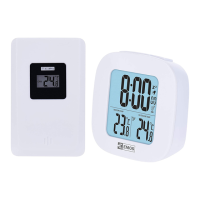6
6. We recommend placing the sensor on the north side of the house.
The range of the sensor may decrease substantially in areas with
large number of obstacles.
7. The sensor is resistant to dripping water; however, it should not be
exposed to sustained rain.
8. Do not place the sensor on metal objects as this will reduce the
transmission range.
9. Replace sensor batteries when the low battery icon is shown on
the display of the sensor.
10. If the thermometer display is dicult to read/weakly backlit, replace
batteries in the thermometer.
Radio Controlled Clock (DCF)
The radio signal propagates via radio waves (77.5 kHz) from a site near
Frankfurt on the Main in Germany within a range of 1 500 km. This radio
time signal automatically takes into account summer and winter time,
leap years and date changes.
After registering the wireless sensor, the thermometer will automatically
begin searching for DCF signal.
The
icon will be ashing. During the search, no other items on
the display will be updated and the buttons will be disabled (except
SNOOZE/LIGHT). Once the signal is detected, the icon will stop ashing
and the display will show the current time along with
icon.
During summer time, the icon will be displayed below it.
If DCF signal is not detected, the
icon will not be displayed.
Long press the button to search for DCF signal again. Long press the
button to cancel the search for DCF signal.
DCF signal will be synchronised daily every hour between 1 and 5 a.m.
Note: If the thermometer detects the DCF signal but the current time on the
display is incorrect (e.g. shifted ±1hour), make sure to always correctly set
the time zone for the country where you are using the thermometer; see
Manual Setting of Time and Date.
In standard conditions (at safe distance from sources of interference,
such as TV sets, computer monitors), the reception of time signal takes
several minutes.

